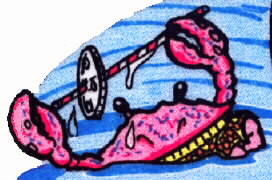| Objective: To learn
about certain characteristics of marine debris and how these characteristics
affect where marine debris is found in the environment.
Activity: Students perform experiments to examine whether trash
can float, blow around, or wash away. The effects of these characteristics
on the presence of marine debris in the environment are then discussed.
Vocabulary: Buoyant
Materials:
· Enough copies of the "Trash Traits
Results" handout for each student in the class
· Several pieces of plastic, glass,
rubber, metal, paper, wood, and food trash
· A bucket filled with water
· A fan
· A large shallow container (such
as a large dishpan)
· A watering can
Subjects: Language arts, science
Learning Skills: Analyzing, classifying, collecting data, comparing
and contrasting, experimenting, hypothesizing, observing
Duration: 40 minutes
Grade level: 4-12
|
Lesson Activities
1. Pass out the "Trash Traits
Results" handouts. With the students, put the different types of trash
(plastics, glass, rubber, metal paper, wood and food) into separate piles.
Have the students name the pieces of trash. Write the names on the board
and have the students fill in the "item" and "type" columns of their handouts.
2. Fill the bucket with water. Place each trash item in the water
and as the students the following questions:
· Which
items float? Which do not? (Make a list on the board and have the students
fill in the "Does it float?" column on their handouts.
· What
will happen to buoyant items when they get into the ocean? What could be
some of the problems be with buoyant marine debris?
· What
will happen to items that don't float when they get into the ocean? Is
there a tendency for all of the articles of the same type (Plastic, paper,
metal, etc.) to float or sink?
3. Set up the fan at one end of the table. Place each trash item
in front of the fan, one item at a time to see if it is blown
around. Ask the students these questions:
· Which
items are easily blown around? (Make a list on the board and have the students
fill in the "Can it be Blown Around on Land?" column on their handouts.)
· What blows
trash around in the environment?
· Is there
a tendency for all of the articles of the same type (plastic, paper, metal
etc.) to be blown around in a similar way?
4. Fill the large shallow container
or a wading pool with water and place in front of the fan. One at a time,
put each article of trash into the container and turn on the fan. Ask the
students:
· Which
items are easily blown around in the water? (Make a list on the board and
have the students fill in "Can it be Blown Around in Water?" column on
their handouts.)
· Is there
a tendency for all of the articles of the same type (plastic, paper, metal,
etc.) to be blown around in the same way?
5. Fill the sprinkling can with water.
Take the sprinkling can and the trash pieces outdoors, and find a slightly
sloped, smooth area (a paved surface on a slight hill would work well).
Place the trash pieces on the sloped area, and sprinkle water on them one
at a time. (Note: this part of the experiment also can be conducted in
the classroom by elevating one end of a board and placing the lower end
in a sink, large container or wading pool. Place the trash pieces on the
elevated end of the board, and sprinkle water down the board.) Ask the
students:
· Which
items are easily moved by the sprinkled water? (When you get back inside
make a list on the board and have the students fill in the "Can Sprinkled
Water Move It?" column on their handouts.)
· What element
in nature acts like sprinkled water?
· Is there
a tendency for all the articles of the same type (plastic, paper, metal,
etc.) to be affected by the sprinkled water in the same way?
6. Discuss how the characteristics
examined (whether an item floats, is blown around, or is carried by sprinkled
water) affect whether an item is likely to become marine debris. Also discuss
how the natural environmental forces of running water, water, and rain
can cause trash to become marine debris. |

